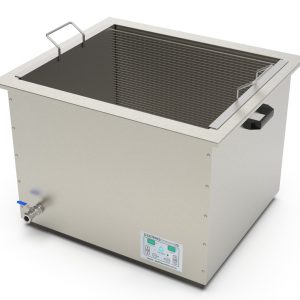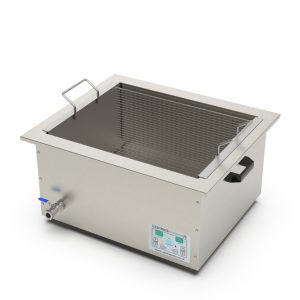Cleaning Diesel Injectors With An Ultrasonic Cleaner
Traditional cleaning of a diesel injector is a laborious task that takes a steady hand, a good eye and often a second pair of hands. At EJ Ultrasonics, we help complete the task in half the time and our equipment reaches the most inaccessible areas ensuring your diesel injectors are cleaned to the highest standard. Cleanliness and safety go hand-in-hand in a motorcar and regular cleaning and maintenance are necessary for sufficient performance.
Our ultrasonic car parts cleaning units use a water-based solution with a small amount of mild detergent ensuring no harsh chemicals remain on the instruments; this offers a more thorough and faster way of deep cleaning the diesel injector whilst reducing labor costs.
What Type Of Ultrasonic Cleaner Should I Use For Diesel Injectors?
Ultrasonic cleaning of car parts is an ideal way to achieve a thorough clean in a timely manner, however, it is important to consider the following factors to ensure you get the results you need without any risk of damage. When deciding on an ultrasonic unit for cleaning fuel injectors, you will want to start by getting the right capacity tank. It must be capable of fully submerging your parts, and so if you intend to clean more than one injector at once, you may want to measure your parts and do the appropriate maths. Remember, for the best clean, you don’t want any parts touching as this may prevent the sonic waves from hitting the surface.
Another important factor to ensure you purchase a suitable unit is the frequency level. The ideal frequency for ultrasonic cleaning of car parts is between 25 and 40 kHz, and while higher frequencies are advised for more delicate parts, anything above 40 kHz will be less effective at removing heavy deposits. Other factors to consider which may affect a unit’s ability to clean diesel fuel injectors are the power, the heater, the brand quality and the material compatibility.
Benefits Of Ultrasonic Cleaning For Diesel Injectors
Ultrasonic cleaning of car parts is a popular method used worldwide as it reaches the most areas. When it comes to diesel fuel injectors, this offers even greater benefits, including the following:
Enhanced Fuel Efficiency
A clean and clear diesel fuel injection part will supply diesel to the intake manifold in the air/fuel ratio intended for best performance.
Better Performance
In the same vein, clogged and dirty injectors will prevent the optimum ratio and affect the performance of your vehicle.
Saving Money
Ultrasonic cleaning of car parts will save money thanks to a faster process and greater fuel efficiency.
Thorough Cleaning
As the process generates microscopic cavitation bubbles, it can access unreachable areas and clean the surface.
Reliable
Like most things in life, if you look after your diesel fuel injectors with regular cleaning and maintenance they will perform better and last longer, with a reduced risk of failure.
Penetration
Ultrasonic cleaning is a fast and effective way of cleaning all parts of your instruments. Easily reaching and penetrating the nozzle and needle seat and clearing blockages from the spout.
Minimal Labour
Ultrasonic cleaning of car parts is as simple as filling a tank, placing the items inside and turning it on, allowing your team to focus on other important tasks.
Simultaneous Cleaning
What’s more, with a larger capacity unit, you can clean more items simultaneously, freeing up even more time for other work.
For information on other car parts that can be cleaned with ultrasonic cleaning, click here.

The Cleaning Process Explained
Choose Your Cleaning Solution
The first thing to do is research and procure a suitable solution for the parts you wish to clean. Remember to consider the material of the item and the type of dirt/debris you are attempting to remove.
Set-Up The Ultrasonic Cleaner
The next step is to fill the tank with only cold water as it will heat up during the process.
Add The Cleaning Solution
You then need to add your cleaning solution to the ultrasonic cleaning system, submerge your parts in the water/solution mix and secure the lid.
Ultrasonic Cleaning Cycle
Set the desired temperature and time and press start. If your unit comes with a degas button, select this before starting as it will remove unwanted trapped air and gas bubbles from the cleaning solution.
Scientific Process
The ultrasonic cleaning system transmits electrical energy that is converted into high-frequency sound waves. The sound waves create cavitation bubbles that produce tiny shock waves which dislodge dirt/debris from the item’s surface.
Rinsing And Drying
Once the cycle has finished, turn off the unit and remove your items. Rinse under cold water to remove any remaining debris and leave them to dry.
Diesel Fuel Injector And Ultrasonic Cleaning Advice
The old adage says prevention is better than the cure and this is a good ethos to live by when looking after the internal parts of your vehicle. Below is some guidance to maintain the peak performance of your diesel fuel injectors.
High-Quality Fuel and Additives
Manufacturers of all makes of cars will recommend using high-quality fuel as it typically contains fewer impurities and a higher energy content, improving your car’s performance and efficiency. It will also have cleaner exhaust, and some are specifically formulated to work better with modern emission systems. Many high-quality fuels also come with superb additives that help to continually clean the engine and improve combustion whilst reducing deposits and emissions. These additives can also prevent waxing or gelling in cold temperatures.
Regular Fuel Injector Maintenance
All vehicle manufacturers will have specific guidelines for how often you should clean your diesel fuel injectors, and these may vary, but there is also expert guidance available that offers a more universal feel. Cars get an annual MOT which should flag any issues with the fuel injectors, but it won’t flag reduced efficiency caused by dirt and debris. Experts suggest cleaning your diesel fuel injectors every 15-30 thousand miles which for some could be each year and others every few years. However, with an ultrasonic cleaning system making the process so simple, it may be prudent to complete the cleaning annually and maintain your car’s peak performance.
Ultrasonic Cleaning Preparation
Make sure your ultrasonic cleaning system is configured appropriately for the task, which includes adding the correct ratio of cold water and cleaning solution to the tank. Remember to only ever use cold water as the mixture will heat up throughout the process and if the liquid becomes too hot, it could damage the item and the ultrasonic cleaner. Select the desired time and temperature for your intended items, utilising the degas button if you have one and leave the unit to complete its cycle.
Material Compatibility
Since an ultrasonic cleaning tank is filled with water, there are many materials that would be unsuitable to be cleaned using this method, including electrics such as microchips, circuit boards, sensors and transducers, fabrics and absorbent materials like sponge or any porous or delicate items. Parts with adhesive joints are also considered unsuitable as the process can sever the adhesive causing the item to break. It is always advisable to check all materials contained in your item and the manufacturer’s advice on suitability before attempting to clean. Diesel fuel injectors will be fine though.
Tank Overcrowding
Similar to cooking food in an oven, crowding too much into an ultrasonic cleaning tank will prevent the waves from reaching all surfaces of the parts and reduce the quality of the cleaning. When it comes to ultrasonic cleaning of car parts, such as diesel fuel injectors, tank placement is paramount because any other parts preventing access to all the remote and inaccessible areas within the instrument will cause loss of energy efficiency, performance and will result in the part needing more regular cleaning. For a thorough clean of your diesel fuel injectors, ensure all submerged items have adequate space to allow the sonic waves to hit them and the cavitation bubbles to penetrate.
Safety First – Take Precautions
As with all electrical items, there is always best practice advice to ensure safety operation, minimising risk to operators and the parts being cleaned. The information is usually supplied in the manual, but you can always find greater details online at the manufacturer’s website. If you are still unsure about anything regarding the operation of your ultrasonic cleaning system, get in touch with our friendly team and we will be more than happy to help.
Reccomended Ultrasonic Cleaning Solutions
With nearly 30 years of expertise in the industry, we at EJ Ultrasonics are always happy to share our knowledge with our customer, ensuring they get the perfect unit for their intended use, like these excellent systems:
AT28i Industrial Ultrasonic Cleaning Unit
This item is among our smaller units, ideal for the cleaning of intricate parts, and its amazing price reflects this. It is perfect for routine cleaning of smaller parts, like washers, nuts, bolts and many more. With an internal capacity of 600 x 500 x 250 mm, it weighs 30 kg and has a capacity of 28 litres. It boasts an impressive 800W of ultrasonic power and a voltage of 220/240V. Operating at 33 kHz, the temperature can reach 80 °C and the cycle can be adjusted from one minute to one hour.
AT200i Industrial Ultrasonic Cleaning Unit
At the opposite end of the size scale comes the sturdy and long-lasting AT200i. With a 200-litre ultrasonic cleaning tank, few auto parts will be too big for this machine, and whilst measuring 700 x 600 x 500 mm, the weight is a surprisingly low 35kg. The AT200i has a significant ultrasonic power of 1KW/2KW but also runs at a voltage of 220/240V. Much like most ultrasonic cleaning systems, it can also be set for any cycle up to one hour and reach temperatures of 80 ° Celsius.



